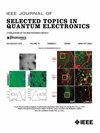Characterization of a Hole-Patterned Microstrip Superconducting Single-Photon Detector
IF 4.3
2区 工程技术
Q1 ENGINEERING, ELECTRICAL & ELECTRONIC
IEEE Journal of Selected Topics in Quantum Electronics
Pub Date : 2025-01-14
DOI:10.1109/JSTQE.2025.3529482
引用次数: 0
Abstract
Superconducting microstrip single-photon detectors (SMSPDs) with near-infrared sensitivity have significant advantages in terms of high quantum efficiency and low dark counts in a large active area. Hole-patterned superconductor microstrips have been reported for fast and efficient single-photon detection. In this work, we fabricated and characterized hole-patterned microstrips with different hole diameters on 5 nm thick MoSi films and an area of 500 × 500 μm2. We observed that the count rate curves of detectors 2 and 3 with holes tend to saturate slightly, whereas those of detector 1 without holes do not. Furthermore, the dark count is similar between detector 1 without holes and detector 2 with small holes and much lower than that of detector 3 with large holes. These experiments indicate that a proper hole is beneficial for efficiency without increasing the dark count rate.求助全文
约1分钟内获得全文
求助全文
来源期刊

IEEE Journal of Selected Topics in Quantum Electronics
工程技术-工程:电子与电气
CiteScore
10.60
自引率
2.00%
发文量
212
审稿时长
3 months
期刊介绍:
Papers published in the IEEE Journal of Selected Topics in Quantum Electronics fall within the broad field of science and technology of quantum electronics of a device, subsystem, or system-oriented nature. Each issue is devoted to a specific topic within this broad spectrum. Announcements of the topical areas planned for future issues, along with deadlines for receipt of manuscripts, are published in this Journal and in the IEEE Journal of Quantum Electronics. Generally, the scope of manuscripts appropriate to this Journal is the same as that for the IEEE Journal of Quantum Electronics. Manuscripts are published that report original theoretical and/or experimental research results that advance the scientific and technological base of quantum electronics devices, systems, or applications. The Journal is dedicated toward publishing research results that advance the state of the art or add to the understanding of the generation, amplification, modulation, detection, waveguiding, or propagation characteristics of coherent electromagnetic radiation having sub-millimeter and shorter wavelengths. In order to be suitable for publication in this Journal, the content of manuscripts concerned with subject-related research must have a potential impact on advancing the technological base of quantum electronic devices, systems, and/or applications. Potential authors of subject-related research have the responsibility of pointing out this potential impact. System-oriented manuscripts must be concerned with systems that perform a function previously unavailable or that outperform previously established systems that did not use quantum electronic components or concepts. Tutorial and review papers are by invitation only.
 求助内容:
求助内容: 应助结果提醒方式:
应助结果提醒方式:


